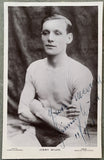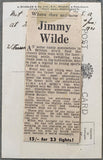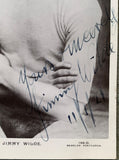WILDE, JIMMY SIGNED REAL PHOTO POSTCARD (1921)
JO Sports, Inc.
Regular price $400.00
HISTORY: Jimmy Wilde (15 May 1892 – 10 March 1969) was a Welsh professional boxer and world boxing champion. He was the first official World Flyweight Champion and was rated by American boxing writer Nat Fleischer, as well as many other professionals and fans including former boxer, trainer, manager and promoter, Charley 'Broadway' Rose, as "the greatest flyweight ever." Wilde earned various nicknames such as, "The Mighty Atom," "Ghost with the Hammer in his Hand" and "The Tylorstown Terror." The record books often show that Wilde started boxing professionally in 1911 but it is widely assumed (and later confirmed by boxing analysts) that he had been fighting professionally for at least four years before that. Wilde's claim that he had at least 800 fights is probably greatly exaggerated, but it was rather more than the 152 shown in Boxrec and elsewhere. Wilde's officially listed debut was on 26 December 1910, when he fought Les Williams to a no-decision in three rounds. His first win came on 1 January 1911, when he knocked out Ted Roberts in the third round. Managed by Teddy Lewis, reserve captain of local rugby club, Pontypridd RFC,[3] Wilde went undefeated in 103 bouts, all of which were held in Britain, a remarkable achievement. In the middle of that streak, on 31 December 1912, he won the British 7 stone championship by beating Billy Padden by an eighteenth-round knockout in Glasgow. He finally lost his undefeated record when he challenged Tancy Lee for the vacant British and Europe Flyweight Championship on 15 January 1915 in London. Wilde was knocked out in the seventeenth round (of twenty). Wilde then embarked on a sixteen-fight knockout streak, and on 14 February 1916, he won the British flyweight title by beating Joe Symonds by a knockout in round twelve at the National Sporting Club in London. On 24 April 1916, Wilde beat Johnny Rosner by a knockout in the eleventh round at Liverpool Stadium to win the IBU World Flyweight title. On 13 May, he had two fights on the same day at Woolwich Dockyard (against Darkey Saunders and Joe Magnus), winning both by knockout, both fights combined lasting less than five rounds. On 26 June Wilde returned to the National Sporting Club to take his revenge on Tancy Lee with an eleventh-round knockout. On 18 December, Wilde became recognised as the first World Flyweight Champion (the IBU title was only recognised in Europe) when he defeated Young Zulu Kid of the United States whose seconds threw in the towel during the eleventh round of their bout at the Holborn Stadium. In 1917, he retained the title by beating George Clarke by a knockout in four. With that win, he also won the European title and recovered the British title. But that would be his last title defence, as soon he decided to vacate the world title. He kept fighting and winning, and in 1919, he beat Joe Lynch, another boxer who was a world champion, by decision in 15. In 1920, he went undefeated in 10 fights, but then, he lost by a knockout in 17 to former World Bantamweight Champion Pete Herman, who outweighed Wilde by more than a stone (14 pounds), in 1921. The bout was originally scheduled as a title defence, but Herman had lost his championship to Lynch the month before. Herman easily regained the Bantamweight title from Lynch in July 1921, leading some to suspect that he had left the title behind with Lynch in America intentionally. That was the fight that marked his return to Britain after touring the United States all of 1920. After a win over Young Jennings, he announced his retirement. Wilde postcardreturned to the ring out of a sense of obligation to defend his title against Pancho Villa on 18 June 1923. After losing by a knockout in seven to the Philippines' first world champion, Wilde announced his retirement. Presented here is an original signed photo postcard of Jimmy Wilde.
FULL DESCRIPTION: This is an original, unused, photo postcard of Wilde in bust pose. Boldly signed in ink, "Yours sincerely Jimmy Wilde 11/1/21." Bold, clear image. Clean. Not creased or torn. Notation on back with a press clipping (which can be removed). 3 1/2" x 5 1/2."
Size: 3 1/2" x 5 1/2"
Condition: Excellent






